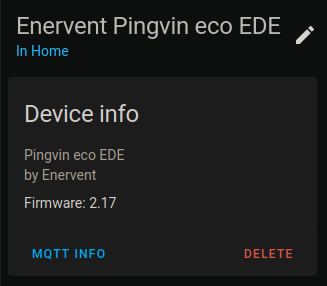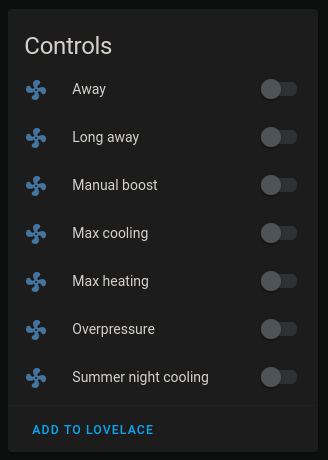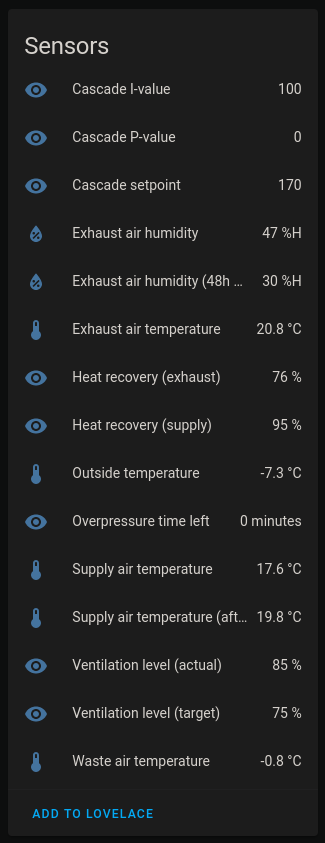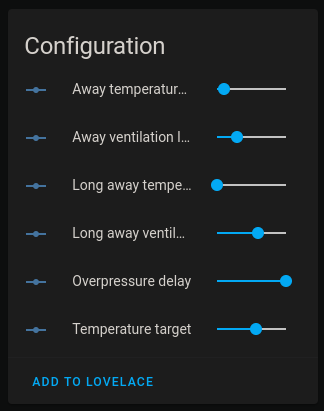An HTTP/MQTT bridge for Enervent EDA ventilation units
An HTTP/MQTT bridge for Enervent ventilation units with EDA or MD automation (e.g. Pingvin, Pelican and Pandion). It
provides a REST-ful HTTP interface for interacting with the ventilation unit (reading temperatures and changing certain
settings), as well as an MQTT client which can publish readings/settings regularly and be used to control the
ventilation unit.
Communication happens over RS-485 (Modbus RTU) by connecting a serial device to the “Freeway” port on the ventilation
unit’s computer board, or alternatively using Modbus TCP for newer units that can be connected to the local network.
/dev/ttyUSB0) connected to the Enervent unit’s Freeway port (seeThe following instructions will install the application to /opt/eda-modbus-bridge.
sudo su -git clone https://github.com/Jalle19/eda-modbus-bridge.git /opt/eda-modbus-bridgecd /opt/eda-modbus-bridgenpm installnpm run build
That’s it, the application is now installed. You can run it manually withnode /opt/eda-modbus-bridge/dist/eda-modbus-bridge.js, or see the next chapter on how to run it as a system service.
The following instructions assume you’ve installed the application to /opt/eda-modbus-bridge.
sudo cp /opt/eda-modbus-bridge/systemd/eda-modbus-bridge.service /etc/systemd/system/sudo systemctl enable eda-modbus-bridgesudo systemctl start eda-modbus-bridge
You can now check that it is running with sudo systemctl status eda-modbus-bridge.
If you need to change any command-line options (e.g. to configure the MQTT broker URL),
edit /etc/systemd/system/eda-modbus-bridge. After you have edited the file you need to reload systemd and restart
the application:
sudo systemctl daemon-reloadsudo systemctl restart eda-modbus-bridge
See https://github.com/Jalle19/home-assistant-addon-repository/tree/main/eda-modbus-bridge
node dist/eda-modbus-bridge.js [options]Options:--help Show help [boolean]--version Show version number [boolean]-d, --device The serial device to use, e.g. /dev/ttyUSB0[required]-s, --modbusSlave The Modbus slave address [default: 1]--http Whether to enable the HTTP server or not[boolean] [default: true]-a, --httpListenAddress The address to listen (HTTP) [default: "0.0.0.0"]-p, --httpPort The port to listen on (HTTP) [default: 8080]-m, --mqttBrokerUrl The URL to the MQTT broker, e.g. mqtt://localhost:1883. Omit to disable MQTT support.--mqttUsername The username to use when connecting to the MQTT broker. Omit to disable authentication.--mqttPassword The password to use when connecting to the MQTT broker. Required when mqttUsername is defined. Omit todisable authentication.-i, --mqttPublishInterval How often messages should be published over MQTT (in seconds) [default: 10]--mqttDiscovery Whether to enable Home Assistant MQTT discovery support. Only effective when mqttBrokerUrl is defined.[boolean] [default: true]-v, --debug Enable debug logging [boolean] [default: false]
There’s a Postman collection under docs/. For more information about the individual endpoints, see
docs/HTTP.md.
When an MQTT broker URL is specified, the application connects to the broker and starts to regularly publish data at
the configured interval (defaults to every 10 seconds). Device information is published only on startup and retained
in the broker.
Every topic is prefixed by eda/, so to subscribe to everything the application sends out, subscribe to eda/#
See docs/MQTT.md for more detailed information about which topics are published and subscribed to.
The application supports Home Assistant’s MQTT Discovery feature, meaning your ventilation unit will show up as a device
in Home Assistant automatically through the MQTT integration. The following entities are available:




Some ventilation units sometimes trip the “TE20 Huoneilma kuuma” alarm when Modbus is used and a room temperature
sensor has not been connected to the main board. This can be alleviated by reducing the polling interval from 10
seconds to something like 30 seconds, or fixed permanently by either connecting an NTC10 temperature sensor or a 10
kilo-ohm resistor to the sensor input terminals (not tested, but confirmed by Enervent).
It is not possible to adjust the ventilation level when the unit is operating in normal mode. Enervent has confirmed
that this is a limitation in the protocol and there is no direct solution. A workaround is to repurpose one of the
modes, e.g. “long away”, to be a “manual control” mode, since the ventilation level can be adjusted for all non-
normal modes of operation. A slight caveat with this is that the temperature target is also reduced, and the
temperature target reduction setting doesn’t always seem to accept values below 2 degrees Celsius. Experiment with
these values to find something that suits your use case, or trust the built-in automation in the ventilation unit to
do its job.
Older firmware (e.g. Pingvin devices with software version 2.01) only support a smaller list of Modbus registers, so
some functionality may be missing. Open an issue if you feel like something isn’t working that should be working.
Unsupported functionality is indicated by the corresponding sensor being disabled in Home Assistant, and the readings
missing from the /summary HTTP endpoint. However, some functionality cannot be reliably detected as available or
not available, so try enabling any disabled sensors you’re interested in to see if they actually report some values.
This seems to be especially common on Pandion units (or any unit that use firmware version 5.x).
While it’s possible to acknowledge any active alarm, serious alarms that cause the unit to enter the “emergency stop”
state require a restart of the unit to resume normal operation. However, the unit cannot be restarted via Modbus
(at least not officially), so it’s best to acknowledge such alarms manually.
Some readings may be nonsensical depending on the exact ventilation unit used, e.g. “Exhaust air temperature
(before heat recovery)” can erroneously show -40 °C.
GNU GENERAL PUBLIC LICENSE 3.0
Some documentation under docs/ is proprietary.
Credits to Jaakko Ala-Paavola for creating https://web.archive.org/web/20201020102005/http://ala-paavola.fi/jaakko/doku.php?id=pingvin
and self-hosting a copy of the relatively hard to find EDA modbus register PDF document.